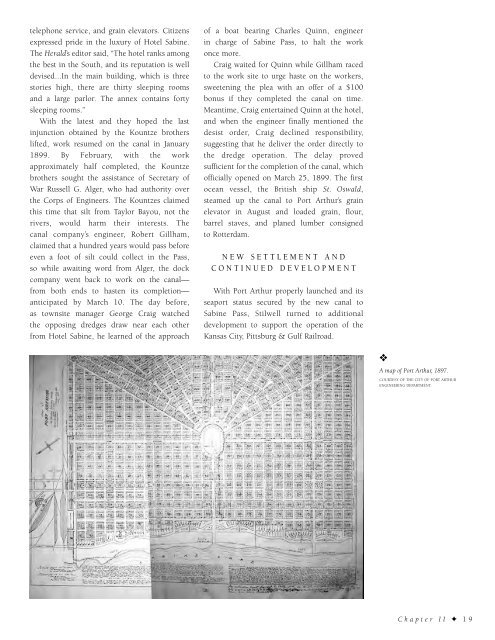Water Rails & Oil - Historic Mid & South Jefferson County
An illustrated history of the Mid and South Jefferson County area, paired with the histories of companies, families and organizations that make the region great.
An illustrated history of the Mid and South Jefferson County area, paired with the histories of companies, families and organizations that make the region great.
You also want an ePaper? Increase the reach of your titles
YUMPU automatically turns print PDFs into web optimized ePapers that Google loves.
telephone service, and grain elevators. Citizens<br />
expressed pride in the luxury of Hotel Sabine.<br />
The Herald’s editor said, “The hotel ranks among<br />
the best in the <strong>South</strong>, and its reputation is well<br />
devised...In the main building, which is three<br />
stories high, there are thirty sleeping rooms<br />
and a large parlor. The annex contains forty<br />
sleeping rooms.”<br />
With the latest and they hoped the last<br />
injunction obtained by the Kountze brothers<br />
lifted, work resumed on the canal in January<br />
1899. By February, with the work<br />
approximately half completed, the Kountze<br />
brothers sought the assistance of Secretary of<br />
War Russell G. Alger, who had authority over<br />
the Corps of Engineers. The Kountzes claimed<br />
this time that silt from Taylor Bayou, not the<br />
rivers, would harm their interests. The<br />
canal company’s engineer, Robert Gillham,<br />
claimed that a hundred years would pass before<br />
even a foot of silt could collect in the Pass,<br />
so while awaiting word from Alger, the dock<br />
company went back to work on the canal—<br />
from both ends to hasten its completion—<br />
anticipated by March 10. The day before,<br />
as townsite manager George Craig watched<br />
the opposing dredges draw near each other<br />
from Hotel Sabine, he learned of the approach<br />
of a boat bearing Charles Quinn, engineer<br />
in charge of Sabine Pass, to halt the work<br />
once more.<br />
Craig waited for Quinn while Gillham raced<br />
to the work site to urge haste on the workers,<br />
sweetening the plea with an offer of a $100<br />
bonus if they completed the canal on time.<br />
Meantime, Craig entertained Quinn at the hotel,<br />
and when the engineer finally mentioned the<br />
desist order, Craig declined responsibility,<br />
suggesting that he deliver the order directly to<br />
the dredge operation. The delay proved<br />
sufficient for the completion of the canal, which<br />
officially opened on March 25, 1899. The first<br />
ocean vessel, the British ship St. Oswald,<br />
steamed up the canal to Port Arthur’s grain<br />
elevator in August and loaded grain, flour,<br />
barrel staves, and planed lumber consigned<br />
to Rotterdam.<br />
NEW SETTLEMENT AND<br />
CONTINUED DEVELOPMENT<br />
With Port Arthur properly launched and its<br />
seaport status secured by the new canal to<br />
Sabine Pass, Stilwell turned to additional<br />
development to support the operation of the<br />
Kansas City, Pittsburg & Gulf Railroad.<br />
❖<br />
A map of Port Arthur, 1897.<br />
COURTESY OF THE CITY OF PORT ARTHUR<br />
ENGINEERING DEPARTMENT.<br />
Chapter II ✦ 19
















